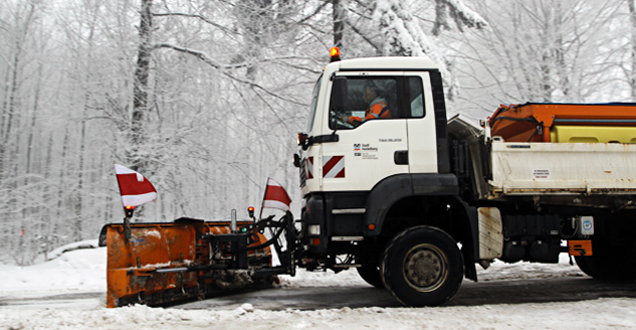
Ready for action: The city’s snow-clearing team
Snow and ice? Bring it on.
Heidelberg is well prepared for sudden snowfalls and icy weather. The municipal snow-clearing team has been on standby since November 17, 2016, ready to keep traffic flowing when wintry weather strikes. It will finally go off-duty on April 14, 2017.
In case of heavy snow and hard frosts, up to 140 municipal snow-clearing personnel are on hand to clear streets and paths around the city from 4 am until 10 pm. The emergency snow-clearing team works as late as 1 am, or at weekends right through to 4 am.
In its depot, the Office of Waste Management and Municipal Cleansing has some 2,200 tonnes of road salt and 20 tonnes of grit at the ready. The pile of salt is five meters high. The city uses between 500 and 2,000 tonnes of deicing salt in a typical winter season – so the five-meter mountain in the warehouse should definitely be enough for the 2016-17 season.
Safety and environmental protection come first
Protecting people and their environment are the primary concerns of the snow-clearing team. To protect the environment, deicing agents must not be used for spreading on sidewalks and footpaths – only materials that provide grip can be used, like sand or grit. Only on slopes can a mixture of salt with grit or sand be used, with salt constituting no more than a third of the total. In places where salt could enter the root area of trees and shrubs, a mixture of this kind is generally not allowed.
When the snow-clearing team is deployed is determined mainly by the forecasts of the meteorological service. In addition, an ice warning system in Ziegelhausen relays real-time local weather information to the team’s headquarters.
Biggest roads first
The first roads to be cleared and gritted are the main traffic arteries, through-roads, streets used by trams and buses, entrances to hospitals, schools and industrial parks, and the main cycle paths. Next in line are the busiest distributor and connecting roads. The municipal snow-clearing team are not required to grit any roads or cycle paths other than those listed above. However, they will clear snow and ice off them as required. Clearing and gritting sidewalks and footpaths is the responsibility of the local residents.
It is up to the residents to keep sidewalks safe to walk on
Members of the public have their own part to play in preventing accidents on ice and snow. According to the relevant city bylaw (kommunale Satzung), residents must clear the snow and ice off public sidewalks, footpaths, stairs and traffic-calmed areas by 7 am on working days or 8 am on Sundays and public holidays, and continue to keep them clear until 9 pm.
- The snow must be pushed to the edge of the sidewalk to allow pedestrians to pass easily. Pedestrians must however still be able to cross over the street.
- To protect the environment, you must not use deicing agents, only materials that provide grip, like sand or grit. Only on slopes can a mixture of salt with grit or sand be used, with salt constituting no more than a third of the total. In places where salt could enter the root area of trees and shrubs, a mixture of this kind is generally not allowed.
Heidelberg’s snow-clearing effort in numbers
- Total length of streets and paths cleared and gritted: 500 kilometers.
- Number of employees available to clear and grit roads and paths: 140.
- Total stocks of salt and grit: 2,200 tonnes and 20 tonnes respectively.
- Number of vehicles equipped with snowplows and grit spreaders: 14.
- Number of compact snowplows for use on cycle paths: 9.





